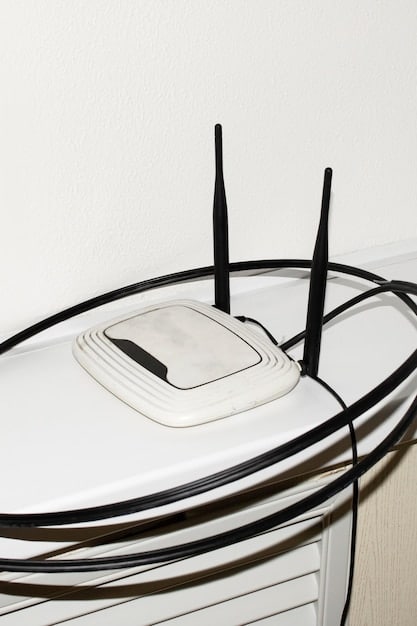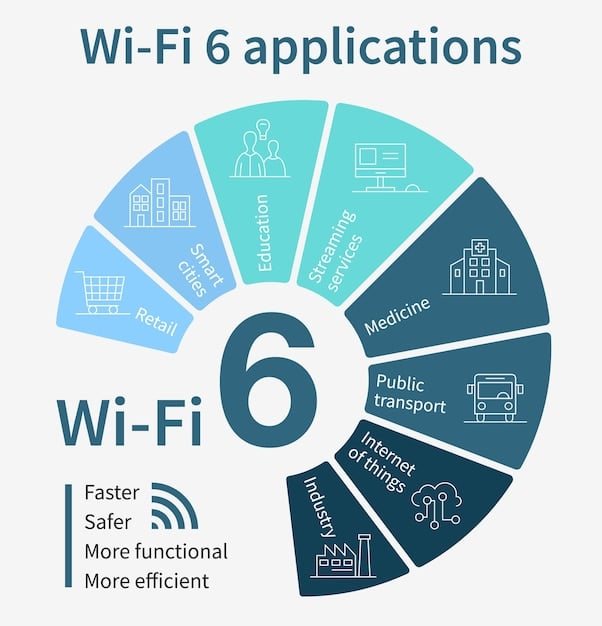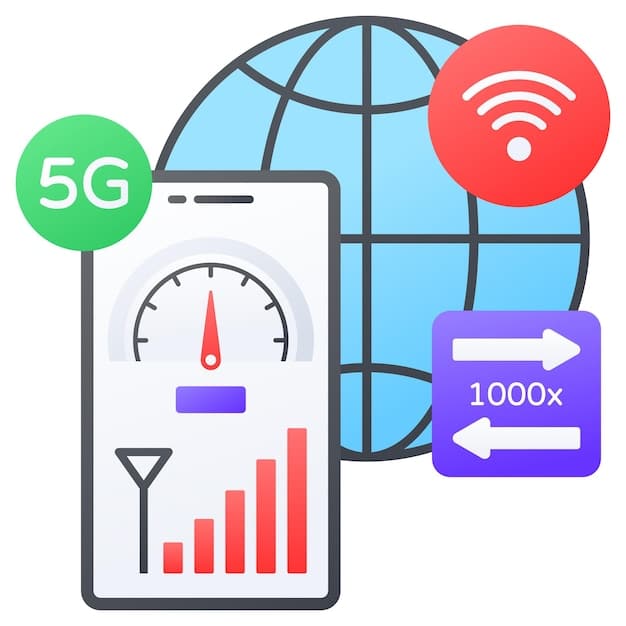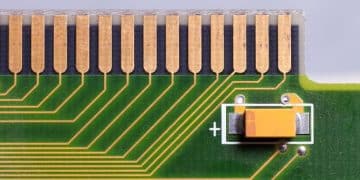Wi-Fi 6 vs Wi-Fi 6E: A Comprehensive Guide for US Consumers

Understanding the Differences Between Wi-Fi 6 and Wi-Fi 6E: A US Consumer’s Guide delves into the nuances of these wireless standards, outlining their benefits, limitations, and suitability for various applications in the US market.
Navigating the world of Wi-Fi can be confusing. Let’s demystify Understanding the Differences Between Wi-Fi 6 and Wi-Fi 6E: A US Consumer’s Guide, and help you decide which is right for you.
What is Wi-Fi 6?
Wi-Fi 6, also known as 802.11ax, is the sixth generation of the Wi-Fi standard. It was designed to improve network efficiency, especially in crowded environments with many connected devices. Let’s dive into the specifics.
Key Features of Wi-Fi 6
Wi-Fi 6 introduces several key features designed to enhance performance and efficiency:
- OFDMA (Orthogonal Frequency Division Multiple Access): Allows a single transmission to deliver data to multiple devices simultaneously, reducing latency and improving overall network efficiency.
- MU-MIMO (Multi-User, Multiple Input, Multiple Output): Enables routers to communicate with multiple devices at the same time, increasing network capacity and speed.
- TWT (Target Wake Time): Allows devices to schedule wake-up times, reducing power consumption and extending battery life.
These enhancements make Wi-Fi 6 a significant upgrade over previous generations, particularly in homes with numerous smart devices competing for bandwidth. With Wi-Fi 6, users can expect more consistent performance, even when multiple devices are actively using the network.
In summary, Wi-Fi 6 enhances network performance through smarter management of bandwidth. This technology is especially useful in densely populated areas and homes with many “smart” appliances that frequently need network connectivity.
What is Wi-Fi 6E?
Wi-Fi 6E is an extension of Wi-Fi 6 that utilizes the 6 GHz band, in addition to the 2.4 GHz and 5 GHz bands. This wider spectrum provides more channels and less interference, resulting in faster speeds and lower latency. Here’s what makes it special:

The 6 GHz band offers a cleaner spectrum, meaning less interference from other devices and networks. This results in more reliable and faster connections, especially beneficial for bandwidth-intensive applications such as 4K video streaming, online gaming, and virtual reality.
Advantages of the 6 GHz Band
The 6 GHz band brings several advantages that enhance the overall Wi-Fi experience:
- More Bandwidth: The 6 GHz band offers more channels compared to the 2.4 GHz and 5 GHz bands, allowing for greater capacity and faster speeds.
- Less Interference: Being a newer spectrum, the 6 GHz band is less congested, reducing interference from older devices and networks.
- Faster Speeds: With more bandwidth and less interference, Wi-Fi 6E can deliver significantly faster speeds than Wi-Fi 6, especially in crowded environments.
Think of the different bands like highways: 2.4 GHz and 5 GHz are well-traveled, filled with traffic, where 6 GHz is like a shiny, new highway with few cars, allowing you to move quickly and efficiently. This analogy simplifies the benefits of Wi-Fi 6E.
In conclusion, Wi-Fi 6E leverages the 6 GHz band to tackle bandwidth constrictions, offering more reliable and faster connections, which are essential for demanding online activities.
Key Differences Between Wi-Fi 6 and Wi-Fi 6E
While both Wi-Fi 6 and Wi-Fi 6E share many of the same underlying technologies, the key difference lies in the spectrum they utilize. Let’s break it down.
Wi-Fi 6 operates on the 2.4 GHz and 5 GHz bands, which are also used by older Wi-Fi standards. This means that Wi-Fi 6 devices have to contend with interference from other devices and networks operating on these bands.
Wi-Fi 6E, on the other hand, utilizes the 6 GHz band, which is a newer and less congested spectrum. This allows Wi-Fi 6E devices to operate with less interference and achieve faster speeds. In simple terms, Wi-Fi 6E offers a cleaner and wider highway for data transmission.
A Detailed Comparison
Here’s a detailed comparison highlighting the key differences between Wi-Fi 6 and Wi-Fi 6E:
- Frequency Bands: Wi-Fi 6 operates on 2.4 GHz and 5 GHz bands, while Wi-Fi 6E operates on 2.4 GHz, 5 GHz, and 6 GHz bands.
- Interference: Wi-Fi 6 is more prone to interference due to the congested nature of the 2.4 GHz and 5 GHz bands, while Wi-Fi 6E experiences less interference due to the cleaner 6 GHz band.
- Speed: Wi-Fi 6E can deliver faster speeds than Wi-Fi 6, especially in crowded environments, thanks to the wider and less congested 6 GHz spectrum.
In short, the main advantage of Wi-Fi 6E is its use of the 6 GHz band, which minimizes network congestion and enables faster and more consistent data transfer speeds.
Benefits of Upgrading to Wi-Fi 6E
Upgrading to Wi-Fi 6E can bring significant benefits, especially for users with high bandwidth demands and numerous connected devices. But is it right for you?

Who Should Upgrade to Wi-Fi 6E?
Consider upgrading to Wi-Fi 6E if you:
- Have Multiple Connected Devices: If you have numerous smart home devices, laptops, smartphones, and gaming consoles, Wi-Fi 6E can provide a more stable and efficient network.
- Require High Bandwidth: If you regularly stream 4K videos, play online games, or use VR/AR applications, Wi-Fi 6E can deliver the faster speeds and lower latency you need.
- Live in a Densely Populated Area: In apartment buildings or crowded neighborhoods, Wi-Fi 6E can help mitigate interference from neighboring networks, providing a more reliable connection.
For households with fewer connected devices or less demanding bandwidth requirements, the benefits of Wi-Fi 6E may not be as noticeable. However, for power users and tech enthusiasts, Wi-Fi 6E can offer a significant improvement in network performance.
Overall, a Wi-Fi 6E upgrade significantly boosts any network with numerous connections or bandwidth-intensive needs, providing enhanced speed and reliability as a result.
Considerations Before Upgrading
Before making the jump to Wi-Fi 6E, there are several factors to consider. Evaluate these points to ensure that it’s the right upgrade for you.
First, check if your current devices support **Wi-Fi 6E**. While Wi-Fi 6E routers are backward compatible with older Wi-Fi standards, you’ll only experience the full benefits if your devices also support Wi-Fi 6E. If you have many older devices, the upgrade might not be worth it until you replace them.
Cost and Availability
Wi-Fi 6E routers and devices tend to be more expensive than their Wi-Fi 6 counterparts. The higher cost is because of the advanced technology and components required to support the 6 GHz band. Also, consider their effective range.
- Budget: Assess your budget and determine if the cost of upgrading to Wi-Fi 6E is justifiable based on your needs and usage patterns.
- Device Compatibility: Check if your existing devices support Wi-Fi 6E to fully utilize its benefits.
- Coverage Area: Assess the coverage area of your home or office to ensure that a Wi-Fi 6E router can provide adequate coverage throughout the space.
In summation, assess device compatibility and budget considerations before upgrading as Wi-Fi 6E may not be fully beneficial without these specific factors.
Future of Wi-Fi Technology
The future of Wi-Fi technology is bright, with ongoing developments aimed at further improving speed, efficiency, and security. What’s on the horizon?
Looking ahead, Wi-Fi 7 (802.11be) is already on the horizon, promising even faster speeds and lower latency. Wi-Fi 7 will introduce features like MLO (Multi-Link Operation) and 4096-QAM, further enhancing network performance.
Trends and Predictions
Here are some trends and predictions for the future of Wi-Fi technology:
- Continued Adoption of 6 GHz: As more devices and routers support Wi-Fi 6E, the 6 GHz band will become more widely used, reducing congestion on the 2.4 GHz and 5 GHz bands.
- Increased Integration with IoT Devices: Wi-Fi will play an increasingly important role in connecting and managing IoT devices, with advancements in power efficiency and security enabling more seamless integration.
- Enhanced Security Protocols: Future Wi-Fi standards will incorporate more robust security protocols to protect against cyber threats and ensure the privacy of user data.
In conclusion, the future of wireless technology appears to be moving towards even faster network performance, better integration with IoT devices, and stronger security protocols to defend against cyber threats.
| Key Aspect | Brief Description |
|---|---|
| 📶 Frequency Bands | Wi-Fi 6 uses 2.4 GHz and 5 GHz. Wi-Fi 6E adds the 6 GHz band. |
| 🚀 Speed | Wi-Fi 6E generally offers faster speeds due to less congestion. |
| 🏠 Best For | Wi-Fi 6E is suitable for crowded homes with high bandwidth needs. |
| 💰 Cost | Wi-Fi 6E routers and devices are usually more expensive. |
[FAQ]
Frequently Asked Questions
▼
Yes, Wi-Fi 6E routers are backward compatible with older Wi-Fi standards like Wi-Fi 5 (802.11ac) and earlier. However, older devices won’t be able to use the 6 GHz band.
▼
No, you don’t need to replace all your devices. Only Wi-Fi 6E-compatible devices will be able to utilize the 6 GHz band. Other devices will still connect using 2.4 GHz or 5 GHz.
▼
The 6 GHz signal’s range is generally shorter than 2.4 GHz and sometimes 5 GHz due to its higher frequency. Expect diminished range through walls.
▼
Wi-Fi 6E uses the latest security protocol, WPA3, which offers enhanced security features compared to older protocols like WPA2. This helps protect your network from cyber threats.
▼
Check the device’s specifications or user manual to see if it supports Wi-Fi 6E or 802.11ax in the 6 GHz band. Most newer devices will list this information clearly.
Conclusion
In conclusion, Understanding the Differences Between Wi-Fi 6 and Wi-Fi 6E: A US Consumer’s Guide reveals that while both standards offer significant improvements over previous generations, Wi-Fi 6E’s use of the 6 GHz band provides a distinct advantage in terms of speed, latency, and reduced interference, particularly for power users and those with numerous connected devices.





